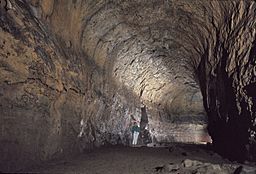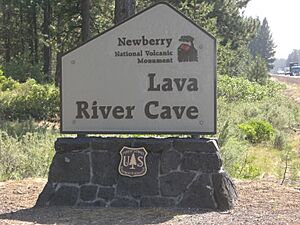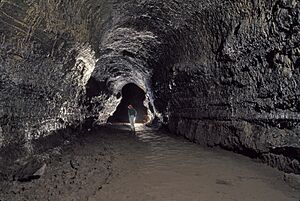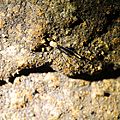Lava River Cave facts for kids
Quick facts for kids Lava River Cave |
|
|---|---|

High arched ceiling in Lava River Cave
|
|
| Location | Deschutes County, Oregon, United States |
| Length | 5,211 feet (1,588 m) |
| Geology | Basalt of Bend |
| Entrances | 2 |
| Access | Public |
The Lava River Cave is a cool underground tunnel near Bend, Oregon. It's part of the Newberry National Volcanic Monument, which is looked after by the United States Forest Service. This cave is super long, stretching 5,211 feet (1,588 m)! That makes its northwest section the longest continuous lava tube in Oregon. People think Native Americans knew about this cave long ago. Later, a hunter officially found it in 1889.
Contents
How Lava River Cave Was Formed
The Lava River Cave was made by a volcano about 80,000 years ago. Imagine a river of hot, melted rock, called lava, flowing downhill. As this lava flowed, its top surface started to cool and harden. This formed a roof over the flowing lava, creating a tunnel.
When the volcano stopped erupting, the lava inside the tunnel drained away. This left behind an empty space, which is the lava tube cave we see today! After the cave cooled down, a part of its roof fell in. This collapsed spot became the entrance to the cave.
The area around the cave gets a lot of rain and snow. Over many years, water has seeped through the ground and cracks in the cave's roof. This water carries sand into the cave. The sand slowly builds up, especially at the far end. Because of this, no one knows exactly how much further the cave goes!
The Cave's Surroundings and Wildlife
The Lava River Cave is about 12 miles (19 km) south of Bend. It's located right off Highway 97. This cave is part of the Newberry National Volcanic Monument. The Forest Service manages this monument as part of the Deschutes National Forest.
Plants Around the Cave
The forest around the cave entrance is full of big ponderosa pine trees. On the ground, you'll find plants like sagebrush, manzanita, and bitterbrush. There are also snowbrush and chokecherries. Near the cave entrance, you might see serviceberry, false Solomon seal, and small willow trees.
Animals Living Near and In the Cave
Many animals live in the forest around the cave. You might spot golden-mantled ground squirrels, chipmunks, and western gray squirrels. Other animals include porcupines, weasels, and mule deer. Once, a cougar was seen running from the cave entrance!
Many birds also live here. Smaller birds include wrens, robins, and juncos. You might also hear woodpeckers and ruby-crowned kinglets. Bigger birds like great horned owls and red-tailed hawks fly overhead.
Inside the cave, you'll find special creatures. Forest Service scientists have found different kinds of spiders, worms, centipedes, and millipedes. There are also mice and bats that live in the cave all year. The bats are very shy, so visitors usually don't see them. Bats often sleep until July. When they are active, they are nocturnal, meaning they are awake at night. If you see a bat, it's important to leave it alone. Waking a bat from hibernation can be very harmful to it.
The Cave's History
Archaeologists believe Native Americans knew about the cave long ago. They found obsidian flakes near the cave. The first official discovery was by a local settler named Leander Dillman in 1889. The story says he found the cave while hunting a wounded deer. He then used the cave to keep his venison cool.
The cave got its name from a geology study in 1923 by Ira A. Williams. This study also created the first map of the cave. In 1938, people tried to dig further into the cave. They hoped it might go all the way to Benham Falls.
In 1926, a company called Shevlin-Hixon Lumber Company gave the land around the cave entrance to the State of Oregon. This land became a park. Later, in 1981, the Forest Service took over the cave and park area. In 1990, the cave became part of the Newberry National Volcanic Monument. The Forest Service still manages it today.
Exploring the Cave
The Lava River Cave goes in two directions from its entrance. The main part goes downhill for 5,211 feet (1,588 m) to the northwest. This section even passes under Highway 97! It's the longest known lava tube in Oregon that hasn't collapsed. The other section goes uphill for 1,560 feet (480 m) to the southeast. This part is closed to the public because of loose rocks.
The Collapsed Corridor and Echo Hall
The cave's entrance looks like a big hole in the ground. To get in, you walk down a rocky path called the Collapsed Corridor. This area was formed when water froze in cracks in the ceiling. The freezing water pushed rocks apart, making them fall. Over time, these fallen rocks created a big pile. You'll go down 126 steps with handrails to get past these rocks. At the bottom, there's a cool chamber. Sometimes, ice forms here and hangs from the ceiling until June!
After a short walk, the ceiling gets really high, about 58 feet (18 m) tall. The cave is also 50 feet (15 m) wide here. This huge archway is called Echo Hall. Its smooth walls make sounds echo loudly. In this section, you can see marks on the walls from the ancient lava flow. These marks look like rounded shelves and lines etched into the rock. Echo Hall ends about 1,500 feet (457 m) into the cave. Here, the cave goes under Highway 97, marked by a small sign.
Low Bridge Lane and Two Tube Tunnel
Past the Highway 97 sign, you enter Low Bridge Lane. Here, the ceiling drops to less than six feet (1.8 m) high. This part of the cave formed after most of the lava had drained out. Hot gases were trapped inside, which re-heated the tunnel walls. As the re-melted rocks cooled, they left a shiny, glazed surface. You might also see volcanic stalactites here, sometimes called lavacicles. Some are hollow tubes formed by escaping gases. Others are cone-shaped drips from re-melted lava.
At the end of Low Bridge Lane, the cave gets narrower. It then splits into two tunnels with connecting passages. This is the Two Tube Tunnel section. Both tubes were probably active lava channels at the same time. But the upper channel eventually drained into the lower one as the lava flow slowed down.
The Sand Garden and Cave's End
One of the most unique parts of the cave is the Sand Garden. It's about 3,000 feet (914 m) from the entrance. The floor here is covered in sand. This sand is fine volcanic ash from the eruption of Mount Mazama 6,600 years ago. Rain and melting snow carried the ash down through cracks in the rock. It was deposited on the cave floor one tiny grain at a time. Sometimes, enough water leaks in to create a pool, which spreads the sand out.
In the Sand Garden, the constant dripping water has carved cool spires and pinnacles in the sand. These delicate sand forms take hundreds of years to build. The Forest Service has fenced off this area to protect them. The last 2,211 feet (674 m) of the cave trail beyond the Sand Garden also has a sandy floor. The ceiling gets lower and lower until the sand fills the cave. The very last 310 feet (95 m) of the cave was dug out of the sand by two men in the 1930s. To explore this final section, you'll need to crawl on your hands and knees. It can take at least thirty minutes to get to the very end.
The air temperature at the cave entrance changes with the seasons, from about 32 degrees to 45 degrees Fahrenheit (-1 to 7 degrees Celsius). But inside the cave, it's always a constant 42 degrees (5.6 degrees Celsius). So, the Forest Service highly recommends wearing a warm jacket when you visit. You can rent lanterns at the visitor center above the cave entrance. You can also bring your own battery-powered lights. Just make sure they provide light for at least an hour. To protect the cave, lights with glass globes or those that use kerosene or white gas are not allowed.
Images for kids






